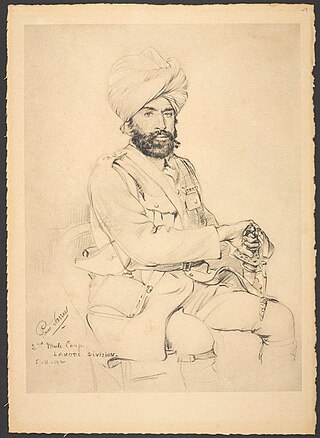The 10th Indian Division was an infantry division of the British Indian Army during World War I. It was formed in Egypt in December 1914 with three infantry brigades of Indian Expeditionary Force F. After taking part in the Actions on the Suez Canal, the division was dispersed as its brigades were posted away.
The 15th Indian Division was an infantry division of the British Indian Army that saw active service in the First World War. It served in the Mesopotamian Campaign on the Euphrates Front throughout its existence. It did not serve in the Second World War, but was reformed at Dehradun in 1964 as part of the post-independence Indian Army.
The 41st Dogras was an infantry regiment of the British Indian Army. The regiment was raised as the 41st (Dogra) Bengal Infantry in 1900 in Jullundur by Major E.T. Gastrell.

The 7th (Meerut) Division was an infantry division of the Indian Army and before 1895, the Bengal Army, that saw active service during World War I.

The 3rd (Lahore) Division was an infantry division of the Indian Army and before 1895, the Bengal Army, first organised in 1852. It saw service during World War I as part of the Indian Corps in France before being moved to the Middle East where it fought against troops of the Ottoman Empire.
The 14th Indian Division was formed during World War I, for service in the Mesopotamian Campaign. It was composed of battalions of the Regular British Army, the British Territorial Force and the British Indian Army.
The 16th Indian Division was an infantry division of the Indian Army during the First World War. It was formed in December 1916, during the First World War. It was the only war formed division of the British Indian Army that was not sent overseas, instead it was sent to guard the North West Frontier. The division took over the responsibilities of the 3rd Lahore Divisional Area when it was disbanded in May 1917.
The 1st (Risalpur) Cavalry Brigade was a cavalry brigade of the British Indian Army formed in 1906 as a result of the Kitchener Reforms. It remained in India during the First World War but took an active part in the Third Anglo-Afghan War in 1919.
The 33rd Indian Infantry Brigade was an infantry brigade of the British Indian Army that saw active service in the Indian Army during the Second World War, notably in the Burma Campaign.
The 34th Indian Brigade was an infantry brigade of the British Indian Army that saw active service in the Mesopotamian campaign in the Indian Army during the First World War. It was reformed for the Second World War as the 34th Indian States Forces Infantry Brigade.
The 11th Gurkha Rifles was a Gurkha regiment of the British Indian Army. It was formed in Mesopotamia and Palestine in May 1918, saw active service in the First World War and the Third Anglo-Afghan War, and was disbanded in April 1922.
The 30th Indian Brigade was an infantry brigade of the British Indian Army that saw active service with the Indian Army during the First World War. It initially saw active service in Egypt in 1915, before transferring to Mesopotamia. It took part in a number of battles and actions before being besieged at Kut and going into Turkish captivity in April 1916.
The 42nd Indian Brigade was an infantry brigade of the British Indian Army that saw active service with the Indian Army during the First World War. It served in the Mesopotamian Campaign on the Euphrates Front throughout its existence. It was not reformed for the Second World War.
The 32nd Brigade was an infantry brigade of the British Indian Army that saw active service with the Indian Army during the First World War. It served in Egypt in 1915 before being broken up in January 1916.
The 35th Indian Brigade was an infantry brigade of the British Indian Army that saw active service with the Indian Army during the First World War. It took part in the Mesopotamian campaign and was disbanded shortly after the end of the war. It was not reformed for the Second World War.

The 37th Indian Brigade was an infantry brigade of the British Indian Army that saw active service with the Indian Army during the First World War. It took part in the Mesopotamian campaign and was disbanded shortly after the end of the war.
The 56th Indian Brigade was an infantry brigade of the British Indian Army that saw active service with the Indian Army during the First World War. It took part in the Mesopotamian campaign and was disbanded shortly after the end of the war. It was not reformed for the Second World War.
The 36th Indian Brigade was an infantry brigade of the British Indian Army that saw active service with the Indian Army during the First World War. It took part in the Mesopotamian campaign and later formed part of the North Persia Force. It remained with the Force until withdrawn in June 1921.
The 28th Indian Brigade was an infantry brigade of the British Indian Army that saw active service with the Indian Army during the First World War. Formed in October 1914, it defended the Suez Canal in early 1915, ended the Ottoman threat to Aden in July 1915, took part in the Mesopotamian Campaign in 1916 and 1917, before finishing the war in the Sinai and Palestine Campaign. It remained in Palestine until it was broken up in 1920.
The Order of battle, Keren 1941 shows Italian army forces that participated in the Battle of Keren from February to March 1941 and British troops in Sudan on 20 January 1941, which participated in military operations against Eritrea during the East African Campaign 1940–1941.


